Part III Assistance for Each Region
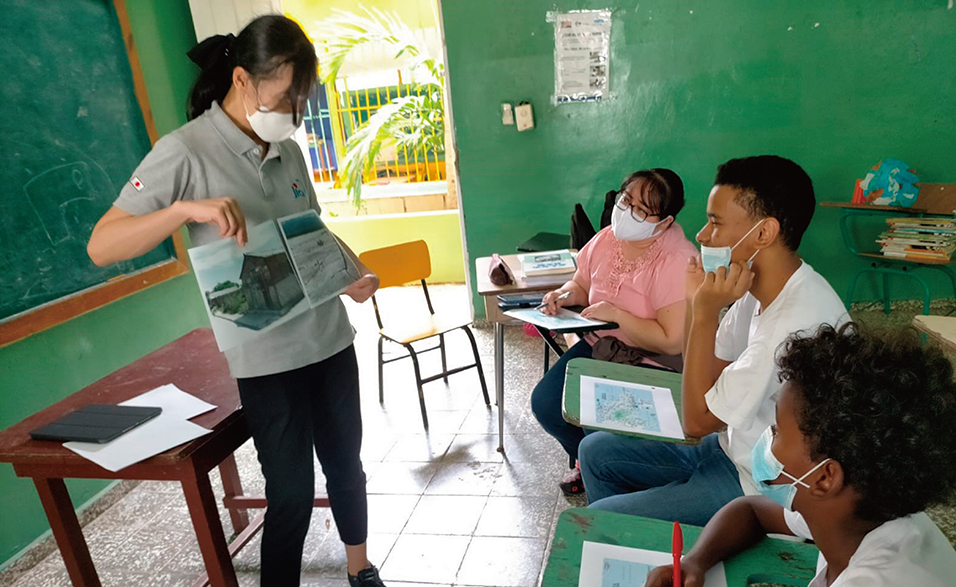
A JOCV for Nikkei Communities giving a class on the history of immigration at a Nikkei Japanese language school in the Dominican Republic (Photo: JICA)
1 East Asia
East Asia consists of a variety of nations, which include countries such as the Republic of Korea and Singapore, which have already attained high economic growth and transitioned from the category of aid recipients to that of donors; least developed countries (LDCs) such as Cambodia and Laos; countries such as Indonesia and the Philippines, which still show large income disparities domestically despite significant economic growth; and countries, such as Viet Nam, which are shifting to a market-driven economy.
● Japan’s Efforts
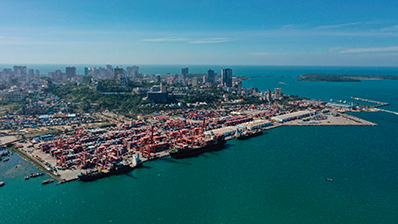
Sihanoukville Port, which is Cambodia’s only deep sea port and accounts for approximately 70% of Cambodia’s container cargo imports and exports (Photo: JICA)
While providing more prioritized support, Japan engages in cooperation that responds to the diverse socio-economic circumstances of East Asian countries and to the changes in the development issues. Japan has contributed to the remarkable economic growth of East Asia by implementing development cooperation that combines ODA with trade and investment, including the development of socio-economic foundations through quality infrastructure investment, support for the development of institutions and human resources, promotion of trade, and revitalization of private investment. In recent years, Japan aims to further enhance open regional cooperation and integration while sharing basic values, to promote mutual understanding through youth exchanges, cultural exchanges, and projects to spread the Japanese language, and to maintain consistent regional stability. In order to make Asia “a center of growth open to the world,” Japan provides support to strengthen the region’s growth and expand domestic demand in each country.
Many countries in East Asia were dealt great societal and economic blows by the worldwide spread of COVID-19. Since its outbreak, Japan has provided a total of approximately ¥38 billion in grant aid for health and medical equipment and technical cooperation to 11 countries in East Asia. Japan has also extended the COVID-19 Crisis Response Emergency Support Loan totaling ¥220 billion to five countries, taking into account the economic impacts. In addition, as of December 2021, over 18 million doses of vaccines manufactured in Japan have been provided to Indonesia, Thailand, Viet Nam, and other countries and regions on a bilateral basis and through the COVAX Facility. Note 1
■ Support for Southeast Asia
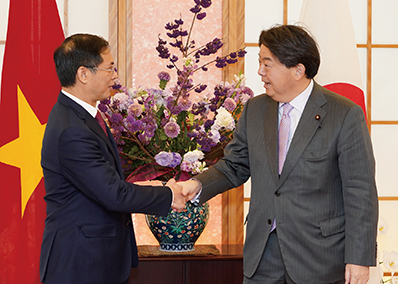
Foreign Minister Hayashi holding a meeting with Foreign Minister Son of Viet Nam during his visit to Japan (November 2021)
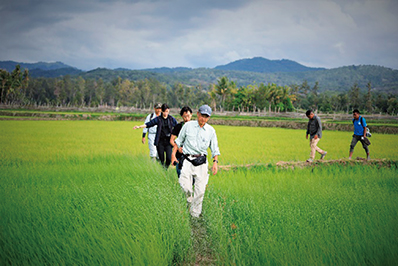
JICA experts visiting rice fields under the “Project for Increasing Farmers Households’ Income through Strengthening Domestic Rice Production in Timor-Leste” (Photo: JICA)
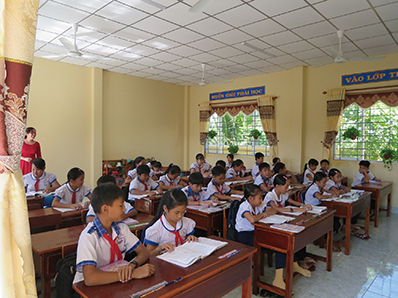
Students at a school building of an elementary school in Long An Province, Viet Nam constructed through Grant Assistance for Grass-Roots Human Security Projects
ASEAN countries Note 2 are located on Japan’s sea lanes and have strong economic ties with Japan, as approximately 14,500 Japanese companies (business establishments) have been operating in the region as of October 2020. The ASEAN region is of great importance for Japan both on the political and economic fronts. ASEAN declared the establishment of the ASEAN Community (2015) and makes efforts to strengthen connectivity and narrow the development gaps within the region. Moreover, the “ASEAN Outlook on the Indo-Pacific (AOIP)”* (2019) advocates the rule of law, openness, freedom, transparency, and inclusivity as ASEAN’s principles of action, sharing many fundamental principles with the “Free and Open Indo-Pacific (FOIP)” promoted by Japan. At the Japan-ASEAN Summit Meeting in November 2020, the Joint Statement of the 23rd ASEAN-Japan Summit on Cooperation on ASEAN Outlook on the Indo-Pacific was adopted. The leaders reaffirmed the shared principles and agreed to further reinforce the ASEAN-Japan Strategic Partnership through enhanced practical cooperation and synergy in the four areas outlined in the AOIP (maritime cooperation, connectivity, the SDGs, and economic and other possible areas of cooperation). Furthermore, at the ASEAN-Japan Summit Meeting in November 2021, a Progress Report that outlines concrete AOIP cooperation progress on the implementation of the Joint Statement was issued (see also “ODA Topics 2”).
Japan enhances cooperation in light of ASEAN’s initiatives in this way and has provided assistance through ODA in a range of areas such as infrastructure development, the rule of law, maritime safety, disaster risk reduction, health and medical care, and peacebuilding, focusing on strengthening connectivity and narrowing the development gaps as its pillars of cooperation. To date, Japan’s ODA for ASEAN countries has amounted to a total of approximately ¥19 trillion. Additionally, in light of the increasing importance of leveraging the financial resources of the private sector and Multilateral Development Banks in the area of development, Japan launched the “Initiative on Overseas Loan and Investment for ASEAN” (2019 Japan-ASEAN Summit Meeting). Under this initiative, Japan contributes to the economic revitalization of ASEAN countries by expanding loans and investment to the private sector in support of SMEs and others in the fields of quality infrastructure investment, improvement of financial access and support for women, and green investment. Moreover, Japan aims to mobilize funding of $3 billion from the public and private sectors centered on funding for ASEAN over three years from 2019 to 2022, and works on providing loans and investment totaling $1.2 billion through JICA. As of December 2021, 11 projects have been adopted for ASEAN countries, with loans and investment totaling approximately ¥44.9 billion.
With regard to strengthening connectivity, Japan supports the enhancement of ASEAN connectivity based on the “Master Plan on ASEAN Connectivity 2025”* (2016 ASEAN Summit Meetings), which aims to strengthen “physical connectivity,” “institutional connectivity,” and “people-to-people connectivity” in the region. Japan signed the Japan-ASEAN Technical Cooperation Agreement (2019) to encourage ASEAN to consolidate its unity and centrality. In accordance with the Agreement, Japan implemented training on cyber security (see “Cyberspace” for details), port management, and marine plastic waste management by FY2020, as well as training on public international law, logistics, and treatment of criminal offenders in FY2021. Moreover, based on the “Japan-ASEAN Connectivity Initiative” (2020 Japan-ASEAN Summit Meeting), Japan provides physical support for the strengthening of ASEAN connectivity in terms of infrastructure, mainly through a total amount of approximately ¥2 trillion for land, air, and sea corridor connectivity infrastructure projects, as well as non-physical support in the form of human resources development for 1,000 individuals contributing to strengthened connectivity for three years from 2020.
In terms of infrastructure development, Japan works to promote “quality infrastructure investment” based on its past experiences of assisting Southeast Asian countries and in accordance with the “G20 Principles for Quality Infrastructure Investment.” Note 3 One such example is Japan’s support for Sihanoukville Port in Cambodia. Sihanoukville Port is Cambodia’s only deep sea port and handles approximately 70% of Cambodia’s container cargo imports and exports. The port’s container cargo handling capacity is becoming strained due to an increase of cargo handling volume as a consequence of Cambodia’s strong economic growth. Japan, at the request of the Government of Cambodia, implements the construction of a new container terminal with a ODA loan and also provides support to improve the efficiency of the port operations through the dispatch of JICA experts and the implementation of technical cooperation projects. By implementing both infrastructure development and technical cooperation together in this way, Japan improves the port’s cargo handling capacity and contributes to the improvement of Cambodia’s logistics functions.
Moreover, in regard to the field of disaster risk reduction and disaster health management, since 2009, Japan has continued to contribute to strengthening disaster management and disaster response capacity in ASEAN with support for the ASEAN Coordinating Centre for Humanitarian Assistance on disaster management (AHA Centre) through the Japan-ASEAN Integration Fund (JAIF), Note 4 including the establishment of an integrated ICT System to strengthen the operation of the AHA Centre, the establishment of a Disaster Emergency Logistic System for ASEAN (DELSA), capacity building of the regional ASEAN Emergency Response and Assessment Team (ASEAN-ERAT) and the AHA Centre Executive (ACE) Programme. Japan has implemented the Project for Strengthening the ASEAN Regional Capacity on Disaster Health Management (ARCH) Note 5 since 2016 and made many achievements, including holding regional coordination drills for disaster health management teams from ASEAN countries and developing standard operation procedures relating to disaster health management. Through cohosted trainings with the World Health Organization (WHO), Japan also works together to strengthen coordination capacities in the field of disaster health management in the ASEAN region in accordance with global standards for disaster health management teams.
In addition, Japan fully supports the establishment of the ASEAN Centre for Public Health Emergencies and Emerging Diseases, including by contributing approximately ¥5.5 billion ($50 million) to JAIF in 2020 and by dispatching experts and providing training through technical cooperation. Japan contributes to strengthening ASEAN’s capabilities to respond to public health emergencies and prepare, detect, and respond to emerging infectious diseases. In October 2021, Japan held online training for public health officials from ASEAN countries responsible for the Centre’s operations. Additionally, Japan has contributed a further $1 million to the “COVID-19 ASEAN Response Fund,” which aims to develop vaccines and procure medical supplies, on top of its contribution through the ASEAN Plus Three (APT) Cooperation Fund.
Furthermore, with regard to the area of human resources development, Japan works on human resources development of approximately 80,000 people over five years from 2019, including in the digital sector such as AI, under the “Industrial Human Resource Development Cooperation Initiative 2.0” (2018 Japan-ASEAN Summit Meeting). Japan has also provided support to Thailand to establish Kosen schools (Colleges of Technology) unique to the Japanese education system in Thailand and implement cooperation to provide Kosen education that meets the same standards as those of Japan in order to develop industrial human resources in the ASEAN region. In addition, Japan implements the “Innovative Asia” initiative, which supports the circulation of competent human resources in Asian countries including ASEAN through studying abroad at Japanese graduate schools or other institutions, internships at Japanese companies, etc., with the aim of promoting innovation in Asia including Japan. Over the five years from FY2017 to FY2021, Japan has accepted people from all across Asia under this project.
In addition, Japan has been engaged in economic cooperation, held investment seminars, invitation programs and “BIMP-EAGA+Japan” dialogue for the East ASEAN Growth Area (BIMP-EAGA). Note 6 In 2021, a fishing port facilities and market were completed on Biak Island in Papua Province, Indonesia.
With regard to the Mekong region, Note 7 which has great potential for development among the ASEAN countries, the Mekong-Japan Summit Meeting has been held since 2009. Around once every three years, it is held in Japan, where the leaders adopt an aid policy framework toward the region.
Japan’s efforts focus on the strengthened connectivity critical for economic growth in the region and it steadily implements projects under the Tokyo Strategy 2018, Note 8 such as the development of the Sihanoukville Port in Cambodia, functional improvements for the Vientiane International Airport in Laos, construction of the Ho Chi Minh City urban railway in Viet Nam, and construction of the Bangkok MRT (Red Line) in Thailand.
Based on the “Mekong-Japan Initiative for SDGs toward 2030” (11th Mekong-Japan Summit Meeting in 2019), Japan makes use of quality infrastructure investment in line with international standards so as to draw out the Mekong region’s potential in an optimal manner, while focusing its efforts on the three priority areas of (i) environmental and urban issues, (ii) sustainable natural resource management and utilization, and (iii) inclusive growth. As a concrete effort for this, Japan provides support for community-based socio-economic development and the realization of the SDGs in the Mekong countries through the “KUSANONE Mekong SDGs Initiative” (13th Mekong-Japan Foreign Ministers’ Meeting in 2020). The 1st Mekong-Japan SDGs Forum was held in December 2021, in which participants shared issues and initiatives of each country and exchanged views. Japan will continue to promote the SDGs in the Mekong region based on the “Mekong-Japan Initiative for SDGs toward 2030” in order to make the region more sustainable, diverse, and inclusive.
Furthermore, as Mekong region countries were dealt economic blows by COVID-19, which caused a lack of development financing, Japan promotes the “Five Points of Cooperation,” including the “Mekong SDGs Investment Partnership” (12th Mekong-Japan Summit Meeting in 2020), in order to support the implementation of development projects by private companies and others: (i) promotion of loans and investment for the private sector, (ii) Grant Assistance for Grass-Roots Human Security Projects that pervades through small communities, (iii) cooperation concerning the rule of law, (iv) cooperation concerning the ocean, and (v) cooperation concerning strengthening supply chains.
The humanitarian situation in Myanmar has deteriorated rapidly due to the impact of COVID-19 and the coup d’état in February 2021, and humanitarian assistance to the people of Myanmar is an urgent issue. Japan actively provides assistance through international organizations and other partners to improve the situation. During 2021, Japan implemented support in the areas of food, nutrition, health, water and sanitation, as well as provided ambulances and oxygen concentrators to respond to COVID-19 (approximately $21 million). In February 2022, Japan announced its decision to provide additional assistance, and decided to deliver food, daily necessities such as shelters and mattresses, medical supplies, and other items to the people of Myanmar through international organizations and the ASEAN Secretariat (approximately $18.5 million). The Government of Japan will continue to proactively provide humanitarian assistance that reaches the people of Myanmar in need, in cooperation with international organizations and the ASEAN Secretariat, taking into account the local situation and humanitarian needs and urgency. Japan will pay close attention to the needs of the people of Myanmar who are facing difficult circumstances.
Thailand
Project for Providing Medical Equipment in Sangklaburi, Kanchanaburi
Grant Assistance for Grass-roots Human Security Projects (September 2016 – May 2017)
Many immigrants and displaced persons from Myanmar live in Sangklaburi District in Kanchanaburi Province, Thailand, which is on the border with Myanmar, with ethnic minorities living along the border area due to its location and historical background. In addition to the current vulnerable medical situation in this region, these people had difficulties accessing appropriate medical care due to their stateless status or economic reasons. Therefore, Ms. JINNO Yoriko, a Japanese nurse, together with her Thai husband, opened the Saan Jai Dee clinic, where they have accepted all patients regardless of their nationality, ethnicity, economic situation, and so on.
Most of the people in this area work in agriculture and factories, etc., and therefore there are many patients who need surgical treatment. However, the clinic did not have sufficient medical instruments, and so could only provide a limited range of medical care and could not carry out even simple surgeries.
In order to improve this situation, Japan provided medical equipment and developed an operating room in the clinic through Grant Assistance for Grass-roots Human Security Projects. As a result, better medical care can be provided to socially vulnerable people, e.g. approximately 500 people were able to receive surgical operations in 2019.
In order to realize human security focused on each and every human being, Japan will continue to implement health and medical care support that aims at “leaving no one’s health behind” and is based in each community.
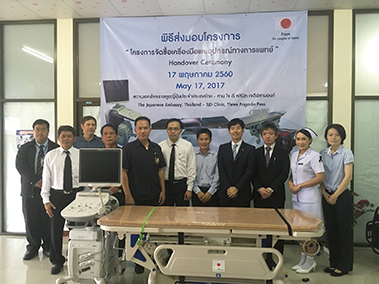
The handover ceremony
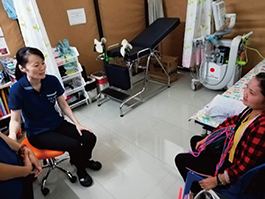
Examining a patient using the provided equipment
■ Termination of ODA to China
ODA to China has played a significant role in strengthening bilateral relations in recent years as well as in the past. In 2018, then Prime Minister Abe announced that Japan would terminate the provision of new ODA to China by the end of FY2018 and promote bilateral dialogues and personnel exchanges in the area of development. All ongoing projects that have already been adopted will be completed by the end of March 2022. Note 9
Glossary
- ASEAN Outlook on the Indo-Pacific (AOIP)
- An initiative to create a vision of even closer cooperation in the Indo-Pacific and strengthen ASEAN-centered regional architecture. It is not aimed at creating new mechanisms or replacing existing ones; rather, it is intended to enhance ASEAN’s community building process and to better face challenges arising from the current and future regional and global environments. It shares many fundamental commonalities with the “Free and Open Indo-Pacific (FOIP)” promoted by Japan.
- Master Plan on ASEAN Connectivity 2025 (MPAC 2025)
- This is the action plan for strengthening ASEAN connectivity that was adopted at the ASEAN Summit in 2016 as the successor document to the “Master Plan on ASEAN Connectivity” (adopted in 2010). It is positioned as a part of “ASEAN 2025: Forging Ahead Together” (adopted in 2015). The document stipulates the five strategic objectives of “sustainable infrastructure,” “digital innovation,” “seamless logistics,” “regulatory excellence,” and “people mobility,” and presents priority initiatives under each of the strategies.
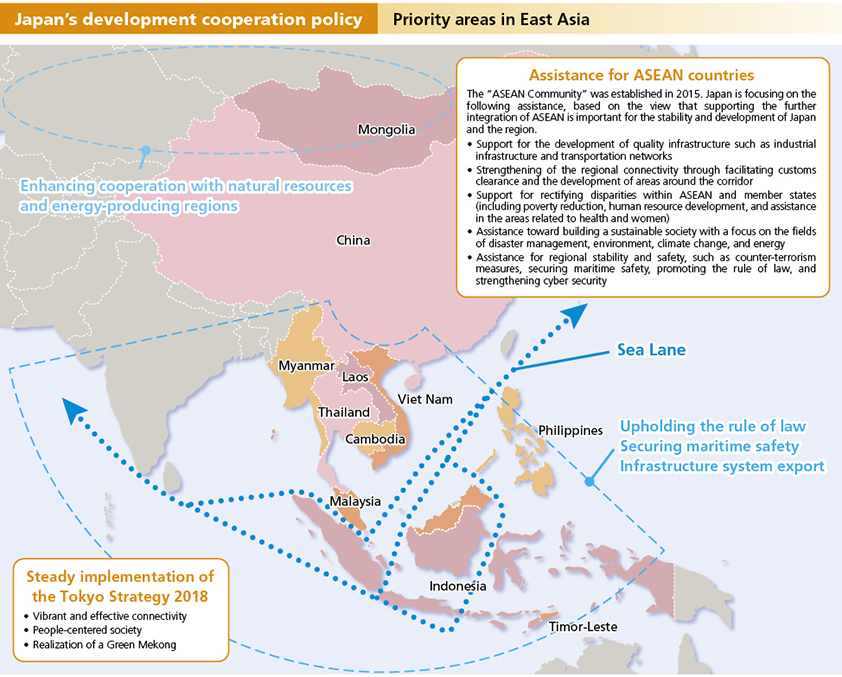
- Note 1: See the glossary.
- Note 2: The 10 ASEAN member states are Brunei, Cambodia, Indonesia, Laos, Malaysia, Myanmar, the Philippines, Singapore, Thailand, and Viet Nam (however, Singapore and Brunei are not ODA recipients).
- Note 3: See the glossary “Quality Infrastructure”.
- Note 4: A fund established in 2006 to support ASEAN’s endeavors to advance integration by correcting regional disparities and aiming at the establishment of an ASEAN Community. Japan announced that it would contribute a total of ¥7.5 billion (approximately $70.1 million) at the 2005 Japan-ASEAN Summit Meeting, and later contributed a total of $100 million to the JAIF 2.0 in 2013. Japan provided additional contributions in 2019 as well as 2020.
- Note 5: A project to create a framework to implement the policy of the ASEAN Declaration on “One ASEAN, One Response: ASEAN Responding to Disasters as One” (2014 ASEAN Ministerial Meeting on Disaster Management). In 2017, the ASEAN Leader’s Declaration (ALD) on Disaster Health Management (2017) clearly incorporated the need for the activities engaged in through ARCH.
- Note 6: A regional framework established in 1994 by Brunei, Indonesia, Malaysia, and the Philippines to promote economic growth in the developing regions of these four countries.
- Note 7: A region including the five countries of Cambodia, Laos, Myanmar, Thailand, and Viet Nam.
- Note 8: Adopted at the 10th Mekong-Japan Summit Meeting in Tokyo in 2018. It outlines the direction of Japan’s cooperation with Mekong.
- Note 9: The projects under implementation as of January 2022 and scheduled to be completed by the end of March 2022 include three technical cooperation projects, the dispatch of two JICA JOCVs, and one JICA Partnership Program.
